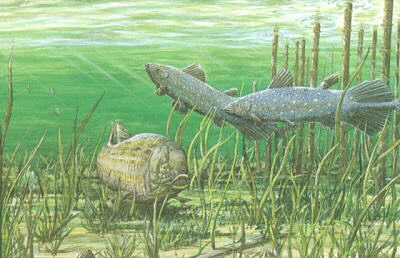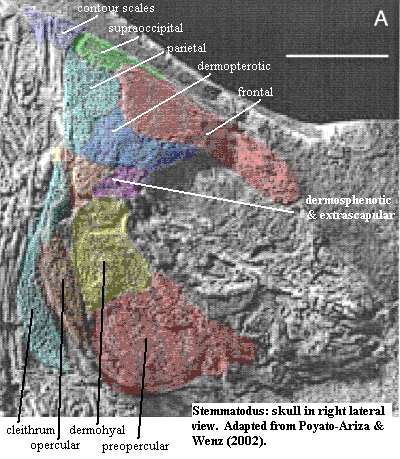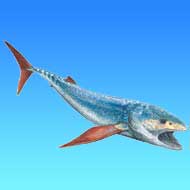
| Palaeos: |  |
Neopterygii |
| The Vertebrates | Semionotiformes |
| Page Back | Unit Home | Unit Dendrogram | Unit References | Taxon Index | Page Next |
| Unit Back | Vertebrates Home | Vertebrate Dendrograms | Vertebrate References | Glossary | Unit Next |
|
Abbreviated Dendrogram
Teleostomi |--Sarcopterygii `--Neopterygii |--Ginglymodi | |--Macrosemiiformes | `--Lepisosteiformes `--Halecostomi |--Halecomorphi | |--Parasemionotidae | `--Amiiformes `--+--+--Semionotiformes | `--Pycnodontiformes `--+--Pachycormiformes `--Teleostei |
Contents
Overview |
 Semionotiformes: Acentrophorus,
Dapedium, Lepidotes.
Semionotiformes: Acentrophorus,
Dapedium, Lepidotes.
Range: Late Permian to Late Cretaceous, cosmopolitan.
Phylogeny: Halecostomi::: Pycnodontiformes + *.
Characters: supramaxilla absent (primitive) [C88]; maxilla does not contact opercular series [C88]; 1+ suborbitals [GB98]; interopercular present [C88]; retain ganoine on scales [C88].
Notes: [1] A strong body of opinion holds that the lepisosteiforms (gars) are members of this taxon. [2] Includes the oldest known neopterygian, the Late Permian Acentrophorus.
Image: from Cartões Postais/ Postcards série Paleontologia Brasileira. The semionotiform Lepidotes is on the left, below the two actinistians (Mawsonia) in this scene from the Cretaceous.
Links: Semionotiformes; temp; The Journal of Vertebrate Paleontology; Class:Osteichthyes; Lepidotes. APW 040806.
References: Carroll (1988) [C88]; Grande & Bemis (1998) [GB98]. .
Range: Late Triassic to Eocene (Miocene? see UCMP) of Africa, Asia, Europe, North & South America.
Phylogeny: Halecostomi::: Semionotiformes + *.
Characters: $? deep-bodied [PW02]; laterally compressed, with
almost circular outline [PW02]; snout large and ventrally expanded [PW02];
premaxilla posterodorsal process thin, elongate & superficial [PW02];
mesethmoid large, robust & forms most of nasal capsule [PW02]; $
mesethmoid T-shaped in cross-section [PW02]; maxilla loose, thin &
unornamented [PW02]; maxilla lost in more derived species [PW02]; $
supramaxilla absent [PW02]; $ frontals short, with strong ventral
curvature [PW02]; frontals often not reaching ventral level of the orbit [PW02];
$? suborbitals present as mosaic of small bones [PW02]; symplectic
articulates with lower jaw as in halecomorphs [C88]; $?
preopercular larger than opercular [PW02]; preopercular separated from
neurocranium by a lacuna [PW02]; $? opercular process of hyomandibular
reduced [PW02]; "dermohyal" present in opercular series
(probably fusion of a dermal bone to hyomandibular) [PW02]; $? subopercular
and interopercular absent [PW02]; $ at least one dermal supraoccipital
present, primitively as unpaired median bones [PW02]; $ parasphenoid
large, toothless & inflected ventrally [PW02]; $ dentary reduced
& usually posteriorly bifurcated [PW02]; $ mandibular symphysis long
& stout [PW02]; coronoid process formed by prearticular [PW02]; $
coronoid process primitively tall, with straight dorsal border [PW02];
prearticular probably incorporates coronoid [PW02]; $? gular reduced to
series of tesserae or even absent [PW02]; 3, and usually 2 pairs of
branchiostegal rays [PW02]; maxilla usually edentulous [PW02]; $
premaxillary teeth columnar to hamate [PW02]; long, flat durophagous teeth
[PW02]; $? crushing teeth on vomer and prearticular, both primitively
circular [PW02]; number of teeth on vomer & prearticular increases with age
[PW02]; vomerine teeth increase size from mesial to distal [PW02]; $
vomerine teeth in rows [PW02]; prearticular teeth arranged in 2-5 rows [PW02]; $
4 dentary teeth [PW02]; notochord not constrained in most species [PW02]; neural
& hemal arches articulate through expanded bases, sometimes also
zygapophyses [PW02]; neural & hemal spines with anterior sagittal flanges
which may overlap precurrent spine [PW02]; $ ribs wing-like  [PW02];
fringing fulcra present, but few [PW02]; cleithrum vertical, with a
ventrally-directed ventral portion [PW02]; squamation frequently reduced; $? specialized
contour scales
(scales forming contour in lateral view) large, reinforced, with stout crest,
often bearing spines [PW02]; contour scales most often present between occiput
& dorsal fin and between cleithrum & anal fin [PW02]; most anterior
dorsal ridge scale fuses with supraoccipital [PW02]; also specialized scales
around cloaca [PW02].
[PW02];
fringing fulcra present, but few [PW02]; cleithrum vertical, with a
ventrally-directed ventral portion [PW02]; squamation frequently reduced; $? specialized
contour scales
(scales forming contour in lateral view) large, reinforced, with stout crest,
often bearing spines [PW02]; contour scales most often present between occiput
& dorsal fin and between cleithrum & anal fin [PW02]; most anterior
dorsal ridge scale fuses with supraoccipital [PW02]; also specialized scales
around cloaca [PW02].
Notes: lots of ordered characters. long-term trends. Sure look like Guildayichthyiforms.
Links: Pycnodontiformes; A new insight into pycnodontiform fishes; 3°) LES POISSONS OSSEUX (French); SyrenCRL; Poissons teleosteens; 207.htm; A Revision of the Pycnodontid genus Macromesodon; First occurrence of Nursallia; Rare Palaeobalistum fish fossil; Cretaceous Lebanese Pycnodontiform Fossil Fish.
Image: (right) from Vertébré Fossiles.
References: Carroll (1988) [C88]; Poyato-Ariza & Wenz (2002) [PW02]. APW 040806.
 Pachycormiformes:
Asthenocormus, Eugnathides, Euthynotoides, Euthynotus, Hypsocormus,
Leedsichthys, Orthocormus, Pachycormus, Prosauropsis, Protosphyraena, Sauropsis,
Saurostomus.
Pachycormiformes:
Asthenocormus, Eugnathides, Euthynotoides, Euthynotus, Hypsocormus,
Leedsichthys, Orthocormus, Pachycormus, Prosauropsis, Protosphyraena, Sauropsis,
Saurostomus.
Range: Late Triassic to Late Cretaceous of Asia, Europe, North & South America
Phylogeny: Halecostomi::: Teleostei + *.
Characters: rostrum bony & elongate [C88]; premaxilla present, small, lateral & mobile [C88]; one supramaxilla present [C88]; symplectic does not reach the articular [C88]; vomers paired [C88]; pectoral fins elongated, serrated, scythe-like [C88]; pelvic fins reduced or absent [C88]; uroneurals probably present [C88]; first hypural separate, with 2nd fused to several others to form broad triangular plate [C88].
Note: Leedsichthys (pictured) has two unique distinctions. First, it is probably the only actinopterygian ever mistaken for a stegosaur. See, Lexovisaurus -- The Dinosauricon. Second, at 10-15 m, it is supposed to have been the largest actinopterygian of all time.
Links: Untitled Document; The CDM's Earth Sciences Resource Site- Pachycormidae; (Hypsocormus & Orthocormus); BBC - Walking with Dinosaurs - Fact Files (Leedsichthys); The Osteology of Leedsichthys problematicus; Fische; Enchodus Mâchoire inférieure Taille - environ 20 centimètres ... (at last, someone who draws worse than I do!); Protosphyraena.
References: Carroll (1988) [C88]. APW 040806.
| Page Back | Unit Home | Page Top | Page Next |
checked APW 040806.